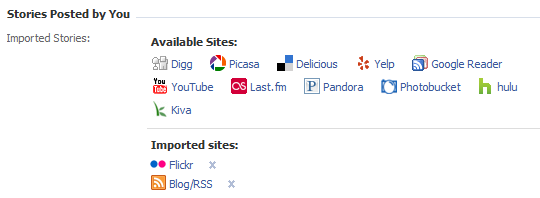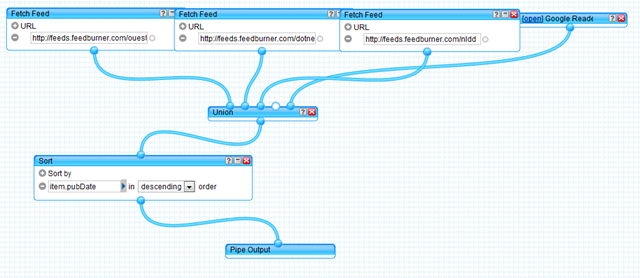Spam your friends with Yahoo! Pipes
You know how it goes: you’re an internet hipster with blogs and Twitter feeds and all that kind of new age stuff, but only other internet hipsters read them. Your friends (at least the ones that are not internet hipsters) only stick to Facebook. So how can you bring your stuff to them?
At first, it seems easy: Facebook can pull “stories” from various websites and services. Go to your profile, and under the status update box, click “Options” and then “Settings”. You get the following interface:

That’s cool for most people. You bring in your Flickr photos, and your blog articles, and maybe a few other things… but what happens if you’ve got more than one blog? The “Blog/RSS” site can be only chosen once. Also, notice how you can choose Google Reader as a story source. Sure, this works, but the way your shared items appear on your wall is not optimal: they appear as “secondary activities”, presented like your comments or likes, sometimes merging several ones together which adds extra clicks to get to the actual article (e.g: “Ludovic shared 2 new items on Google Reader”, with only a link to your shared items page, which means you don’t know which 2 items were shared, as they may not be the last 2 ones if there have been other, newer ones since then). At least it was like that a few months ago (maybe they fixed it in the meantime, you tell me). That’s not proper spamming, so let’s do it the power user way.
A few years ago, Yahoo launched Yahoo! Pipes, a website that lets you build feed mashups. I decided to use that to aggregate all my stuff and post it on my Facebook wall.
It’s pretty simple, at first. You just go to the Yahoo! Pipes website, log-in, click “Create a pipe”, and add one source node for each site you want to pull data from. You’ll most probably use “Fetch Feed” nodes with the direct URL to your blogs and shared items RSS or Atom feeds, but you can also use some “Fetch Site Feed” nodes, too (they will find the actual feed URLs like any feed reader would do). Now pick the “Union” node from the “Operators” category, and plug all your sources into it. Plug the “Union” output into the “Pipe Output” node that should have been created by default for you. Voilà, you have an aggregated feed that you can import on your wall on Facebook!

Or do you?
One problem you’ll notice right away is that all the items from the first feed are displayed, and then all the items from the second feed, and so on… The “Union” node only built a, well, union of those feeds. You need to re-order them by date so that all the items from all the sources are correctly mixed together. For this, add a “Sort” node, as shown above, that will sort items by “item.pubDate”.
There. Fixed? Nope… not yet.
Now you have a user experience problem. All those items appear as “notes” on your Facebook wall, with their contents directly readable. If you’re pulling feeds from your own websites and feeds from elsewhere at the same time (e.g. your Google Reader’s shared items feed), it becomes difficult for your friends to figure out which stuff was written by you, and which stuff is just cool shit you found on the web and wanted to share. You need to create a differentiator, like for example prepend “Shared on Google Reader:” in front of each of your shared items’ titles.
I’m still evaluating different options but at the moment I’m using something a bit less user-friendly, although definitely more friendly to the websites from which I share stuff from: I completely replace the contents of the item with a link to the actual article on its original website. This means that people can’t read the item right there (they need to click on the link), but it also means the people who posted the cool shit in the first place get a visitor that will potentially start clicking around on links and ads if he linked whatever I shared.
For this I created a different pipe, although I could have hard-coded it in the first one.

This pipe basically gets my Google Reader shared items feed and processes it in a loop: for each item, I replace the contents with a link whose text is just the title of the item. Inject this new pipe into the first one (you can reference a pipe inside another pipe) and, at last, you’re done!
The only problem I’ve had so far is that, after adding my aggregated feed to Facebook for the first time, the mobile version of the website did something funky. Instead of weaving all those notes into my friends’ timelines, moving the older items behind the more recent updates from other people and applications, it put everything it could at the top. So basically, I really spammed all my friends with dozens and dozens of items that were several weeks or even several months old. This bug didn’t affect the normal website, neither did it affect the iPhone application, as far as I could tell, so I only got a couple complaints. And hopefully they fixed the bug since then.
That’s pretty much it. You can find the 2 pipes I showed here and here.